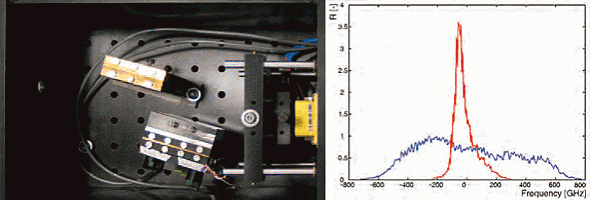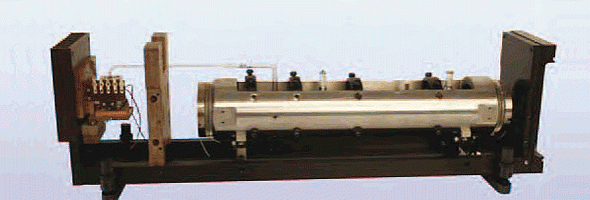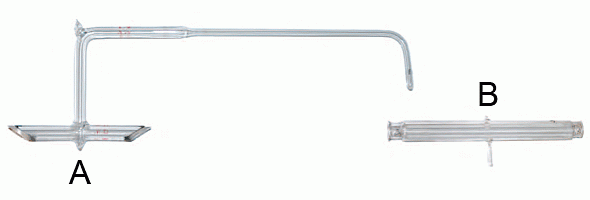Laser for measurement and metrology
In 2010 the laser celebrates its 50th birthday. From the
curiosity that emerged from a scientific laboratory the laser has found its way
into nearly all households. Among thousands of various applications laser
dimensional measurement is one of the best known. In the laboratories of ISI the
first Czech He-Ne laser was built only three years after its world premiere and
its design has been gradually developed for the needs of Czech metrology.
This long history has produced our offered experience in the following
fields:
- Spectral modification (narrowing) of the emitted wavelengths of gas and semiconductor lasers.
- The design of lasers for metrological applications with extreme stability of the emission optical frequency.
- Manufacturing of cells filled with hyperpure gasses for absorption spectroscopy.
- The design and realization of interferometric measuring systems.
- The design and deposition of optical interference coatings.
- The design and realization of special electronics for control of experiments.
Lasers with high coherence for measuring purposes
Lasers designed at ISI are unique due to their high coherence and are suitable for:
- precision length measurements on the basis of laser interferometry;
- analysis of gases and other transparent media through laser spectroscopy.
ISI is equipped with laser sources with high coherence operating at the
following wavelengths: 502 nm, 532 nm, 543 nm, 633 nm, 760 nm, 780 nm,
1064 nm, 1315 nm, 1540 nm. If required this set may be broadened to include
additional wavelengths.
Examples of realized designs:
- He-Ne lasers and discharge tubes for the construction of He-Ne lasers. We designed technology for manufacturing and filling of the gas He-Ne lasers that dominate in the field of precise length measurements. These lasers are thermally stable and are suitable for operation as laser sources for measuring systems based on laser interferometry. Compared with commercial lasers our design offers fast wavelength tuning via an integrated piezoelectric transducer.
- ECL lasers for measurement and spectroscopy. Traditional He-Ne lasers operating in the visible spectral range are only tunable within a very narrow range. Laser diodes perform much broader tuning range but do not operate in a single-frequency regime and are thus not suitable for demanding applications like interferometry and spectroscopy – for example, for gas analysis. We designed semiconductor laser technology with an extended cavity, which effectively reduces the laser emission spectral profile and keeps the laser's broad spectrum of available wavelengths accessible through tuning. We achieved a compact tunable laser source suitable for spectroscopic applications with an operating wavelength given by the laser diode of choice.
- Laser systems with laser diodes VCSEL, DFB and DBR. We designed specialized electronics for controlling the wavelength of commercial laser diodes operating with a narrow emission spectral range. These are the diodes with vertical cavity VCSEL (Vertical Cavity Surface Emitting Laser), distributed optical feedback DFB (Distributed FeedBack) and wavelength selective mirrors DBR (Distributed Bragg Reflector). The emission wavelengths of these diodes are controlled by the injection current of the semiconductor and also through the operating temperature. The control electronics are equipped with a set of signal processors controlling the operating point of the laser diode.
Contact:
Assoc. prof. Josef Lazar, Dr.
e-mail: joe@isibrno.cz
phone: +420 541 514 253
Detailed information: http://www.isibrno.cz/kgs

He-Ne laser: the discharge tube made of quartz glass
High-power ECL lasers
High power ECL lasers are based on a similar technology of linewidth
narrowing as the highly coherent ECL lasers for spectroscopy. They include an
extended cavity with a wavelength selective mirror – an optical grating.
Further linewidth narrowing was achieved through external “injection
locking” using a Ti:Sa laser.
We designed:
- a power semiconductor laser with ECL configuration featuring 1.5 W of output power for laser polarization of the Xenon nuclei through spin exchange with Rubidium atoms. The polarized Xe is used as a contrast medium for magnetic resonance tomography. Similar power lasers are utilized as atmospheric communication transmitters for long-range free-space optical communications.
Contact
Assoc. prof. Josef Lazar, Dr.
e-mail: joe@isibrno.cz
phone: +420 541 514 253
Detailed information: http://www.isibrno.cz/kgs

design of a high-power laser with ECL configuration which uses a broad-stripe power laser diode (left), the line-narrowing effect of this setup (right)
Laser etalons of optical frequencies
Etalons of optical frequencies (wavelengths) are highly coherent lasers
generating an output light with precise optical frequency (wavelength). The
frequencies are in the order of hundreds of THz, which corresponds to the
wavelength range of 500 – 1500 nm. These lasers operate as primary sources
for the realization of the international definition of the unit of length –
they are used by metrological institutions as sources of light for measuring
laser interferometers. Regular calibration of mechanical length etalons by a
system with direct traceability to the fundamental etalon of length is a key to
any industrial metrology. Precision and stability of these laser etalons
influences the whole chain of metrology, from the fundamental down to the
industrial level. ISI is traditionally engaged in this technology and a set of
the fundamental etalons of (wave)lengths has been developed here.
Examples of realized systems:
- Stabilized He-Ne laser at the 633 nm wavelength. The He-Ne laser with stabilization of its optical frequency developed at ISI is one of the fundamental etalons of wavelength and at present is used as a national etalon of length. The optical frequency of the He-Ne laser is stabilized through saturated absorption in the iodine vapor by the technique of derivative spectroscopy. This is a final product of the ISI – a compact system equipped with electronics including computer control. Relative stability of the laser is on the 10-11 level for 1s integration time. It is used for the calibration of He-Ne laser sources for interferometric systems.
- Nd:YAG stabilized laser at the 532 nm and 1064 nm wavelengths with absorption in iodine. Vapor of molecular iodine is the most common absorption medium for the stabilization of lasers in the visible spectral range. This offers a dense set of narrow hyperfine transitions with the best signal-to-noise ratio close to the 500 nm wavelength. Iodine stabilized Nd:YAG lasers (Nd:YAG–I2) can reach stabilities close to the 10-14 level. ISI operates an experimental system based on the Nd:YAG laser generating stable optical frequencies at wavelengths of 532 and 1064 nm.
- Stabilized system at the 1315 nm wavelength. This system was designed according to the specifications and needs of the „Prague Asterix Laser System“ (PALS) research center. We designed a system based on a narrow-linewidth DBR laser diode operating as a “master oscillator” at the front end of a cascade of optical amplifiers. This is a laser with fiber optic output with a frequency stabilized through linear absorption in vapor of dissociated iodine. Detection and control is fully automatic and the instrument is controlled by several signal processors. The laser operates at the 1315 nm wavelength, in the telecommunication spectral range. It can also serve as an etalon for optical telecommunications.
- Etalon DFB laser at the 1540 nm wavelength for optical communications. According to the needs of Czech Telecom (today Telefonica) we designed a stabilized laser operating as an etalon of optical frequency in the near infrared spectral range 1540 nm. The core of the system is a DFB laser diode with high coherence. The system operates with the stabilization of frequency through spectroscopy of the 13C2H2 acetylene and offers tuning over one of the spectral components of acetylene within the tuning range of up to 200 GHz. The system can be used for the calibration of wavemeters and spectral analyzers and for the adjustment of laser transmitters in optical telecommunication systems with a wavelength multiplex, so-called DWDM (Dense Wavelength Division Multiplexing).
- Femtosecond synthesizer of optical frequencies. In the laboratories of ISI we operate two systems for the synthesis of optical frequencies based on femtosecond pulsed lasers operating in the visible and infrared spectral range. The optical synthesizer allows the direct transfer of relative stability of frequencies between radiofrequency and optical spectral ranges, and they serve as references (etalons) of optical frequencies for metrology, interferometry and spectroscopy. Both systems will soon be linked to the reference of H2 maser with relative stability at the 10-15 level.
Contact:
Ing. Ondřej Číp, Ph.D.
e-mail: ocip@isibrno.cz
phone: +420 541 514 254
Detailed information: http://www.isibrno.cz/kgs

Iodine-stabilized He-Ne laser designed at ISI with control electronics and software for operation in metrology centers
Absorption cells for spectroscopy and etalons of optical frequencies
Absorption cells are made primarily for laser spectroscopy of gasses and to
be used as references for laser frequency stabilization onto selected spectral
components. The production technology of absorption cells in ISI is realized in
a specialized glassmaking workshop, and the cells are custom designed mostly for
national metrological institutions such as PTB in Germany, NIST in the USA and
BIPM in France.
Examples and parameters of manufactured cells:
- Cells made of quartz glass with wedged windows with antireflection coated inner and outer window surfaces or with windows under the Brewster angle.
- Cells filled with superpure gasses (acetylene 13C2H2, methane, xenon, krypton) or saturated vapor of iodine, cesium, rubidium, etc. Cells filled with iodine serve as s reference for the primary etalons of (wave)length. The frequency shifts of iodine cells made at ISI are the smallest in the world (below 1 kHz of the optical frequency). The technology of the ISI allows the preparation of cells filled with various media based on application requirements.
Contact:
Assoc. prof. Josef Lazar, Dr.
e-mail: joe@isibrno.cz
phone: +420 541 514 253
Detailed information: http://www.isibrno.cz/kgs

Iodine cell with Brewster angle windows designed for He-Ne laser etalon of optical frequency at 633 nm wavelenght (A) and iodine cell with wedged windows (B)
Laser interferometric measuring systems
Laser interferometric measuring systems are based on the interference of two
or more laser beams and represent a tool for the measurement of distances and
other geometrical quantities. The scale of their potential application is very
broad, and they may be used for the measurement of short distances in the range
of millimeters or over meters or tens of meters. However, the primary resolution
is in the range of tens of nanometer.
Systems designed at ISI are used for:
- the measurement of the position of three-axis positioning stages;
- the calibration of scales of a broad range of various position sensors;
- measurements of the refractive index of air.
Examples of applications:
- Interferometry for nanometrology. Nanometrology is based on the imaging of samples using techniques of local probe microscopy, primarily Atomic Force Microscopy (AFM). When the scale of the objects in the nanoworld has to be measured the positioning of the AFM probe must be measured through interferometry with a direct link to the primary etalon of length (stabilized laser). The setup for measuring the probe is derived from a nanopositioning stage and a system of interferometers monitoring the sample position in three or even all six degrees of freedom. The local probe microscope is placed over the sample. The limits of uncertainty of the measurements are given by the mechanical stiffness of the whole setup and by the fluctuations of the refractive index of air. The resolution is below 1 nm.
- Precise positioning systems and comparators. Interferometric systems designed at ISI can offer resolution at the 0.1 nm level, i.e. the resolution of interatomic distances. Practical applications of these positioning and measuring systems are in the field of scale calibration of various position sensors used in industrial measurements.
- Measuring of the refractive index of air of gaseous media. At the ISI laboratories we are also involved in the development of measurement techniques for the refractive index of gasses. We operate two systems for evaluation of the refractive index of air that can be used to measure any other transparent media, liquids and solid materials.
- Interferometry with compensation of the refractive index of air. An arrangement with differential measurement allows compensating the influence of variations of the refractive index of air. The basis of the configuration is a mechanical reference with very small thermal expansion, and the wavelength of the laser source is locked to its length through the sum value of the two counter measuring interferometers.
Contact:
Assoc. prof. Josef Lazar, Dr.
e-mail: joe@isibrno.cz
phone: +420 541 514 253
Ing. Ondřej Číp, Ph.D.
e-mail: ocip@isibrno.cz
phone: +420 541 514 254
Detailed information: http://www.isibrno.cz/kgs

Laser comaparators for calibration of position sensors – system for horizontal calibration (left), system for measuring of the refractive ondex of air with He-ne lasers (right)
Special electronics and software
The design of special electronics for the control of experiments and data processing including software represent an important part of the research activities of our group. This includes:
- low noise current controllers for laser diodes;
- precise temperature controllers for laser diodes and absorption cells;
- digital systems for phase sensitive detection;
- cards for signal digitization with A/D and D/A converters;
- high-voltage amplifiers for piezoelectric transducers;
- complete detection chains for derivative and frequency-modulation spectroscopy;
- communication interfaces for TCP/IP, USB and CAN busses and networks;
- power supplies and photodetectors.
Software developed at ISI includes:
- an original algorithm for linearization of the laser interferometer scale;
- a communication server for processing and data transfer through TCP/IP in real time;
- drivers for the LabView environment;
- control software for the CAN bus.
Contact:
Ing. Ondřej Číp, Ph.D.
e-mail: ocip@isibrno.cz
tel: +420 541 514 254
doc. Ing. Josef Lazar, Dr.
e-mail: joe@isibrno.cz
tel: +420 541 514 253
Detailed information: http://www.isibrno.cz/kgs



